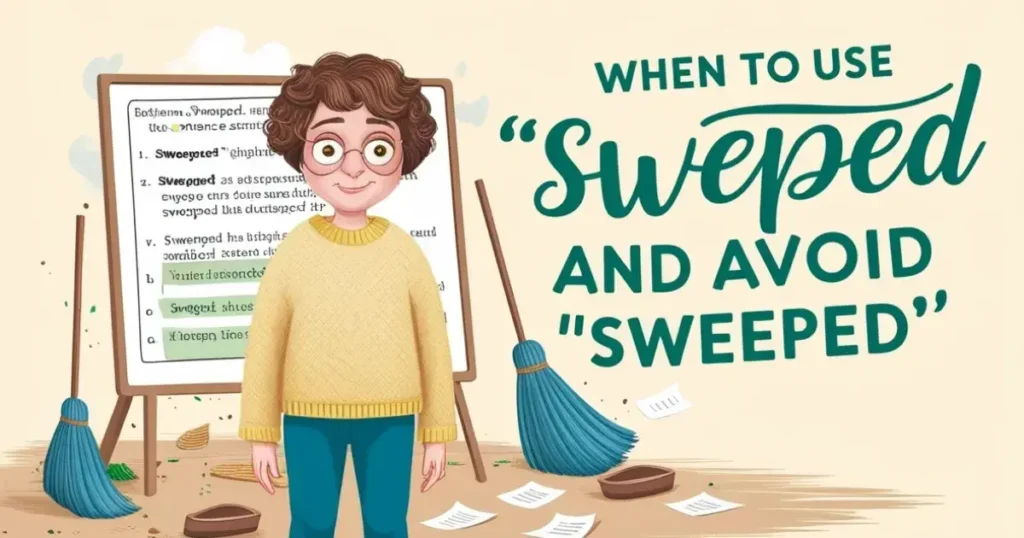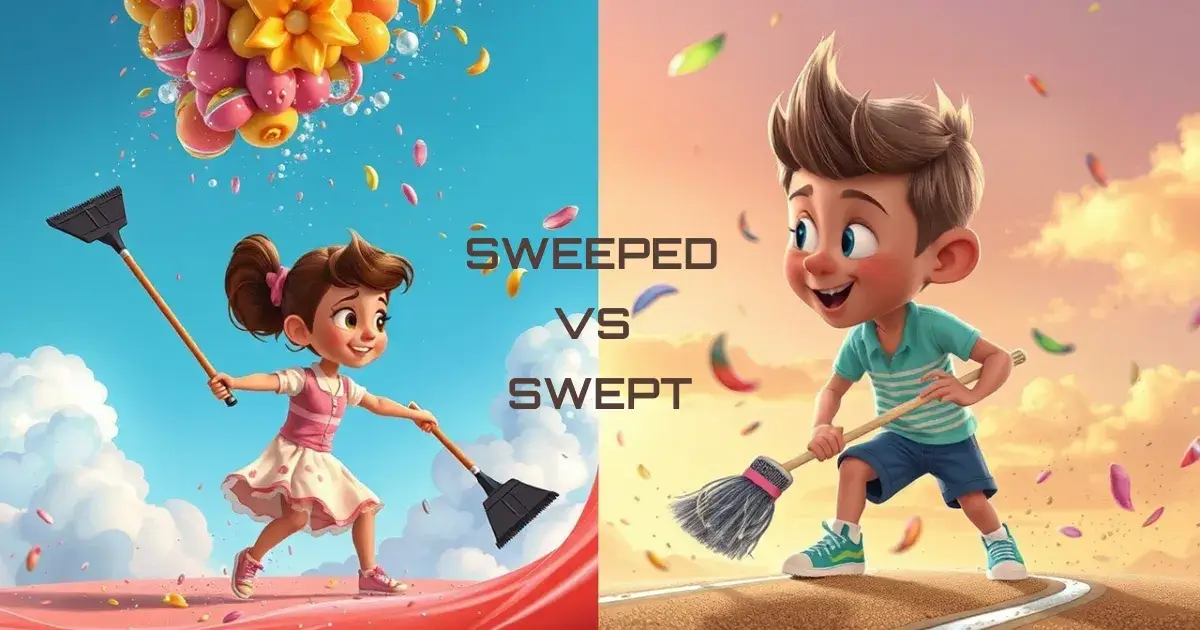English can be tricky, especially when it comes to words that sound similar but have distinct meanings or forms. A perfect example of this is the confusion between “sweeped vs swept.” This article dives deep into the difference between these two terms, clarifies the proper usage, and provides helpful examples to ensure you never mix them up again.
Why “Sweeped” vs “Swept” is Confusing
It’s easy to assume that “sweeped” is the past tense of the verb “sweep,” as it follows the regular pattern of adding “-ed” to form the past tense, just like “talk” becomes “talked” or “play” becomes “played.” However, when it comes to “sweeped vs swept,” the past tense of “sweep” is “swept”, not “sweeped.” Many people mistakenly use “sweeped” because it seems logical, but it’s actually a grammatical error. Understanding why “swept” is correct will help you avoid confusion in both spoken and written English.
In this article, we will cover:
- The definitions of both terms
- The grammatical differences
- Common usage scenarios
- Why “sweeped vs swept” is often misunderstood
- And more.
Let’s break it down in simple terms, starting with the basic definitions of each.
Definitions and Usage
Swept

The word “swept” is the past tense and past participle form of the verb “sweep,” which means to clean or clear away dust, dirt, or debris by using a broom, brush, or other cleaning tool. “Swept” is an irregular verb form, meaning it doesn’t follow the typical conjugation pattern of adding “-ed” to the root verb.
Examples:
- “She swept the floor this morning.”
- “The storm swept through the town, leaving destruction in its wake.”
Sweeped
While “sweeped” might seem like a logical choice based on how other regular verbs work in the past tense, it is not a valid word in standard English. This form is commonly used mistakenly by people who may have heard the word but don’t realize that the correct form is “swept.”
Understanding Irregular Verbs
What are Irregular Verbs?
Irregular verbs are a unique group of verbs in the English language that do not follow the standard rules of conjugation for the past tense. Typically, regular verbs form their past tense by adding “-ed” to the base form (e.g., talk becomes talked, play becomes played). However, irregular verbs don’t follow this predictable pattern, making their conjugation a bit trickier.
Instead of simply adding “-ed,” irregular verbs undergo changes that may involve vowel shifts, entirely new forms, or sometimes no change at all. As a result, irregular verbs often need to be memorized because they don’t follow a consistent pattern, unlike regular verbs.
Why “Sweep” is an Irregular Verb
The verb “sweep” is an excellent example of an irregular verb. Its past tense form isn’t created by just adding “-ed” to the base form (like regular verbs). Instead, “sweep” changes to “swept” in the past tense. The change from “sweep” to “swept” is an example of a vowel shift, a common feature of many irregular verbs in English.
Here’s how it works:
- Base form (present tense): Sweep
- Past tense: Swept
- Past participle: Swept
In this case, the “ee” in “sweep” changes to “e” in “swept,” which is an irregular transformation. This is why it’s essential to learn irregular verbs separately, as they don’t follow the same rules as regular verbs.
Contrast with Regular Verbs
Regular verbs, on the other hand, follow the simple rule of adding “-ed” to the base form to create the past tense. Let’s look at a couple of common regular verbs for comparison:
- Talk (base form) becomes Talked (past tense)
- Play (base form) becomes Played (past tense)
In both cases, the past tense is formed by adding “-ed” at the end of the verb, making it very straightforward. These are examples of regular verbs because they don’t change in any irregular way like “sweep” does.
Why Does This Matter?
Understanding the difference between regular and irregular verbs is essential for mastering verb conjugation and speaking or writing grammatically correct sentences. For example, you wouldn’t say “I sweeped the floor,” because “sweeped” is not a valid word in English. Instead, you would say, “I swept the floor,” following the irregular verb pattern.
This distinction also helps with standard English usage. While irregular verbs like “sweep” can be confusing at first, remembering their forms will ensure that your communication is clear and accurate.
Synonyms of “Swept”
Let’s explore 10 synonyms for “swept” to deepen our understanding:
- Cleaned
- Mopped
- Brushed
- Removed
- Cleared
- Gathered
- Collected
- Washed
- Broomed
- Tidied
Each of these synonyms can replace “swept” in different contexts, but none of them can replace it when you’re talking about the past tense of the verb “sweep.”
Why “Swept” is Correct

The past tense of the verb “sweep” is “swept,” and this form is grammatically correct for several important reasons. Let’s dive into why “swept” is the accepted form and how it fits within the rules of English grammar.
Grammatical Reasons Why “Swept” is Correct
“Swept” is the past tense of “sweep” because “sweep” is an irregular verb in English. Irregular verbs don’t follow the standard rule of simply adding “-ed” to the base form to indicate past tense (which is common with regular verbs). Instead, these verbs undergo a change in their spelling or structure when forming the past tense. In the case of “sweep”, the vowel change from “ee” to “e” leads to the past tense “swept.”
In grammar terms, this means “sweep” is a strong verb—it changes its internal structure, usually in a predictable manner based on historical forms of English. This makes “swept” the correct past tense form of “sweep.”
Thus, “swept” is the form that adheres to the grammar rules of standard English. It has been historically and linguistically accepted as the proper past tense of “sweep.” When we use “swept”, we are following the established convention of English conjugation for this specific verb.
Comparison with Other Irregular Verb Forms
Understanding irregular verbs can help clarify why “swept” is the correct form. Irregular verbs are notorious for not following a uniform pattern of conjugation, which is why English learners often struggle with them. However, they do tend to follow patterns within their own category. “Sweep” follows a similar transformation as other common irregular verbs. Here are some examples:
- “Sleep” becomes “slept” (similar vowel change from “ee” to “e”).
- “Keep” becomes “kept” (again, a vowel change).
- “Feel” becomes “felt” (another example of a vowel change).
- “Weep” becomes “wept” (same vowel shift as “sweep”).
These verbs, like “sweep,” exhibit a common characteristic of irregular verbs: they undergo a vowel shift to form the past tense. They don’t follow the standard “-ed” ending of regular verbs.
If we compare these forms:
- Present tense: Sweep / Sleep / Keep
- Past tense: Swept / Slept / Kept
Notice the vowel shift in each case. Just as “sweep” changes to “swept,” other verbs like “sleep” and “keep” follow the same irregular conjugation pattern. This type of change is part of what makes these verbs irregular and why “swept” is correct.
How Understanding Irregular Verbs is Essential for Mastering English Grammar
Mastering irregular verbs is a key component of fluent English because irregular verbs are incredibly common in everyday speech and writing. If you don’t understand the correct forms of irregular verbs, such as “swept,” you might find yourself using incorrect forms like “sweeped”, which is a grammatical error.
Why is this important?
- Clarity and Precision: Using the correct verb forms, like “swept”, ensures your speech and writing are clear and precise. People will immediately understand that you are referring to an action that was completed in the past.
- Professionalism: In formal writing, especially in academic or professional contexts, using proper grammar—including correct verb forms—is essential. An improper form like “sweeped” could lead to misunderstandings or make your writing appear less credible.
- Consistency: Understanding irregular verb forms, like “swept”, helps maintain consistency in both speech and writing. Regularly using the correct past tense form (instead of “sweeped”) contributes to your overall mastery of English grammar.
Comparison Table: “Sweeped” vs “Swept”
Here’s a simple comparison table highlighting the core differences between “sweeped vs swept”:
| Feature | Sweeped | Swept |
|---|---|---|
| Definition | Incorrect form of the past tense of “sweep.” | Correct past tense of “sweep.” |
| Grammatical Error | Yes | No |
| Usage in Sentences | Nonstandard English; incorrect | Standard English; accepted form |
| Synonyms | None | Cleaned, removed, gathered, etc. |
| Verb Conjugation | Follows regular pattern (-ed) | Irregular (no “-ed” suffix) |
| Example Sentence | Incorrect: “I sweeped the floor.” | Correct: “I swept the floor.” |
When to Use “Swept” and Avoid “Sweeped”

Now that you know the difference between “sweeped” and “swept,” it’s time to explore when to use “swept” in your writing and speaking:
- Use “Swept” when referring to the past tense of “sweep.”
- Example: “She swept the house clean yesterday.”
- Never use “Sweeped” since it is not a valid word in standard English grammar. Stick to “swept” when talking about past actions.
- Example: Incorrect: “He sweeped the floor.” Correct: “He swept the floor.”
Common Examples of “Swept” in Sentences
The word “swept” is used in many different contexts, usually referring to the act of cleaning, clearing, or being moved by force. Here are several real-life, everyday examples of how to use “swept” in sentences:
1. Cleaning and Tidying Up
- “She swept the floor yesterday.”
- In this sentence, “swept” refers to the action of cleaning the floor using a broom. It indicates that the action happened in the past (yesterday).
- “I swept the kitchen after dinner.”
- Here, “swept” is used to describe the act of cleaning the kitchen by sweeping the floor. It’s a simple action that’s part of daily life.
- “They swept the patio to clear the dust.”
- This example shows how “swept” can refer to cleaning outside spaces like a patio or yard, which can gather dirt or debris.
2. Movement or Force
- “The wind swept the leaves away.”
- “Swept” in this sentence refers to the natural force of the wind, which caused the leaves to move or be blown away. This is a common usage when describing things being carried or moved by wind or water.
- “A strong current swept the boat downstream.”
- Similar to the previous example, “swept” here describes the movement caused by water, where the current pushed the boat along.
- “The storm swept across the city, causing widespread damage.”
- In this case, “swept” describes how the storm moved through the area, emphasizing its force and speed.
3. Figurative Uses
- “Her performance swept the audience off their feet.”
- Here, “swept” is used figuratively, meaning to deeply impress or emotionally move the audience.
- “The news of the victory swept through the town.”
- This example uses “swept” to describe how information or news quickly spread through the community.
- “His kindness swept away my worries.”
- In this sentence, “swept” conveys how someone’s actions removed or alleviated the speaker’s concerns in a comforting way.
4. Sweeping Actions in Past Tense
- “I’ve swept the dust from the table.”
- This example uses the present perfect tense, showing that the action of sweeping the table has already been completed at some point before now.
- “The cleaners swept the entire office before the meeting.”
- “Swept” is used to indicate that the cleaners performed the action of sweeping the office in the past, preparing it for a meeting.
- “She had swept the floor before anyone arrived.”
- This sentence uses the past perfect tense, meaning the action of sweeping was completed before another past event (the arrival of others).
5. Miscellaneous Examples
- “I accidentally swept the crumbs off the counter.”
- In this case, “swept” refers to the unintentional action of brushing crumbs off the counter while cleaning or moving something.
- “After the party, we swept up all the decorations.”
- Here, “swept” refers to gathering up items that were left behind after a social event.
- “The team swept through their competition, winning every match.”
- “Swept” is used metaphorically to describe the team dominating their competitors with ease.
Everyday Usage Examples of “Swept”

Let’s take a look at some real-life examples of “swept” to help solidify your understanding of this term:
- “I swept the kitchen after dinner.”
- “The strong winds swept through the valley.”
- “The leaves were swept into the street by the wind.”
- “After the party, they swept the floor clean.”
Notice how “swept” is used consistently in the past tense to indicate that an action happened at some point in the past. It’s never “sweeped,” no matter how tempting that might seem!
“Sweeped” or “Swept” Meaning
To summarize, the correct form is “swept,” and it refers to an action that took place in the past. It’s essential to use “swept” in both formal and informal settings, as it adheres to the rules of English grammar and avoids common grammatical errors.
If you’ve ever wondered, is sweeped a word? The answer is clear: No, sweeped is not a word. Always use “swept” when referring to the action of sweeping that has already occurred.
Swept Pronunciation and Meaning in Hindi
To clarify the meaning of “swept,” in Hindi, swept can be translated as “साफ किया (saaf kiya),” which conveys the idea of cleaning or tidying up.
Pronunciation of “Swept”
- Phonetic: /swɛpt/
- The “e” sound in “swept” is short and pronounced like the “e” in “bet.”
Commonly Made Mistakes: “Sweeped or Swept”
Let’s address some of the common mistakes people make when deciding whether to use “sweeped or swept”:
- Mistake: “She sweeped the floor.”
- Correction: “She swept the floor.”
- Mistake: “I sweeped it all up yesterday.”
- Correction: “I swept it all up yesterday.”
Remember: “Sweeped” is not correct; always use “swept” to describe past actions of sweeping.
Spell “Swept” Correctly Every Time

The verb “sweep” is often misspelled when trying to form its past tense. If you’re unsure how to spell swept, just remember:
- S + W + E + P + T = Swept
- Keep this spelling in mind when writing or speaking, and avoid falling into the trap of mistakenly using “sweeped.”
Conclusion: “Sweeped vs Swept”
To sum up, the debate between “sweeped” vs swept has a simple solution: the correct past tense of sweep is “swept.” While “sweeped” may seem like a reasonable option, it is not a valid word in English. Always use “swept” when referring to an action that happened in the past.
By keeping in mind the rules of verb conjugation and the importance of standard English in writing, you can ensure that your grammar remains accurate and polished.
So, next time you’re about to write or speak about sweeping something, remember: “sweeped” or swept—always choose swept!
FAQs
What does sweeped mean?
“Sweeped” is an incorrect form of the verb “sweep” and is not accepted in standard English. The correct past tense is “swept.”
What is the correct past tense of sweep?
The correct past tense of “sweep” is “swept,” not “sweeped.”
Is sweeped a word in a sentence?
No, “sweeped” is not a valid word in English; the proper past tense form is “swept.”
Is swept a real word?
Yes, “swept” is the correct past tense and past participle of “sweep” and is widely used in English.
Which is correct sweeped or swept?
“Swept” is the correct form, while “sweeped” is an incorrect, nonstandard version.
How do you spell swept under the rug?
The phrase is spelled as “swept under the rug,” referring to something being hidden or ignored.

This author is a passionate linguist and grammar enthusiast, dedicated to helping individuals master the art of language. With years of experience in teaching and editing, she brings clarity and precision to every sentence. Tina’s mission is to empower writers of all levels to express themselves with confidence and excellence.

